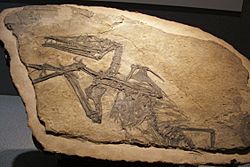Eudimorphodon facts for kids
Quick facts for kids EudimorphodonTemporal range: Upper Triassic,
|
|
|---|---|
 |
|
| MCSNB 2888 in Milan | |
| Scientific classification | |
| Kingdom: | |
| Phylum: | |
| Class: | |
| Order: | |
| Suborder: | |
| Family: |
Eudimorphodontidae
|
| Genus: |
Eudimorphodon
Zambelli, 1973
|
| Species | |
|
|
Eudimorphodon was a type of flying reptile called a pterosaur. It lived a very long time ago, during the Upper Triassic period. Its fossils were first found in Italy in 1973, preserved in a type of rock called shale.
Meet Eudimorphodon
A nearly complete skeleton of Eudimorphodon was discovered in 1973. This fossil showed that it was a member of the long-tailed group of pterosaurs, known as Rhamphorhynchoidea.
Eudimorphodon was quite small. Its jaw was only about 6 centimeters (2.4 inches) long. But packed into that small jaw were 110 teeth!
Its Amazing Teeth
The teeth at the very front of Eudimorphodon's mouth were like small fangs. Further back, the teeth were tiny and had multiple points, often five on each tooth. This kind of tooth is very special among pterosaurs. Most other pterosaurs had simple, cone-shaped teeth.
When Eudimorphodon closed its mouth, its top and bottom teeth touched directly. This was especially true for the teeth at the back of its jaw. The unique shape of its teeth and the way they wore down suggest that Eudimorphodon could crush or chew its food.
What It Ate
Scientists found the remains of a small fish, called Parapholidophorus, in the stomach of a fossil Eudimorphodon. This tells us that fish were part of its diet.
The wear patterns on its teeth also suggest that Eudimorphodon ate hard-shelled invertebrates. These are animals without backbones, like crabs or snails. Young Eudimorphodon might have had slightly different teeth and fewer of them. They may have mostly eaten insects.
A Tail Mystery
One interesting puzzle about Eudimorphodon is its tail. Unlike other long-tailed pterosaurs, its tail was flexible. Other long-tailed pterosaurs had very long, stiff bones in their tails. These stiff tails helped them stay stable when flying.
A flexible tail means the animal could move around more easily in the air. However, it would also need more control from its brain to fly steadily. Scientists are still trying to understand why Eudimorphodon had such a flexible tail.
Images for kids
See also
 In Spanish: Eudimorphodon para niños
In Spanish: Eudimorphodon para niños



